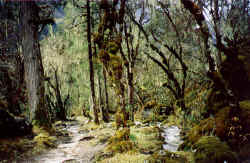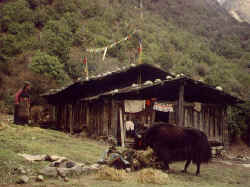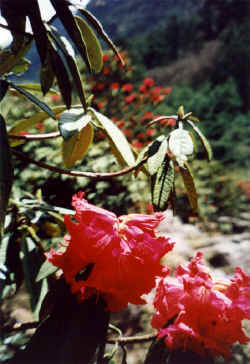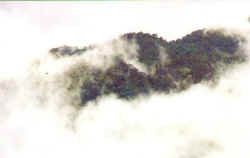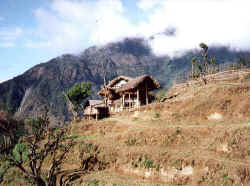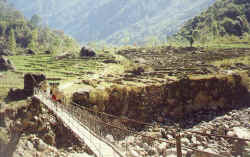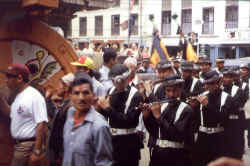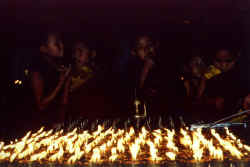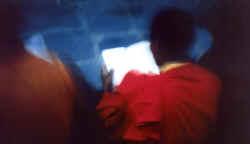MyHimalayasimpressions from |
|
|||||||
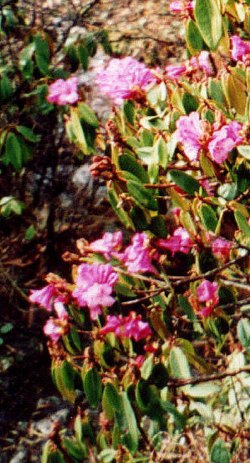
Enchanted forest between Ghunsa and Phale, small creeks murmur between moss-covered boulders.
Yaks are loaded for their journey to the pastures.
Rhododendrons in spring
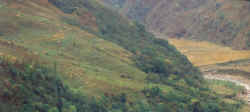
Terraces in the Tamuar valley near Taplejung.
The morning's rain evaporates within 20 minutes after the afternoon sun starts to shine.
Rai house at the end of our trip
Newari festival in Patan.
Buddhist novices enjoying the festival in Boudha.
Kangchenjunga: Ghunsa - Suketar - Kathmandu
Ghunsa - Suketar - Kathmandu
Ghunsa - Gyabla - Thyangyam (Day 19)
Again the rain must turned into snow at night, covering the hills with a few inches. I wake up early and finish packing quickly. Our kitchen crew also just got up, when I see that 'the family' is also up I go over to their house. A few cups of buttertea are equivalent to a full breakfast (at least calorie-wise) and instead of having breakfast at camp I stay with the family for a little longer. We take some pictures, I hope Joel will be in Ghunsa in again next season and can give them some copies. Postal service to remote areas is so unreliable that it is not even worth trying.
I pay my bill, 450 rupees (6 US$) for two nights, 5 full meals, some snacks and endless cups of tea. Walking in bright sunshine through forests when it rained the night before makes it even more pleasant, the smells and colors are more intense. Since Phale was a pleasant village on the way up, I leave before the rest of the group to have more time there.
The little side creeks are coming down in cascades and waterfalls, the scenery is much greener than two weeks ago. Rhododendrons are in full bloom, small flowers spring from bushes and out of the grass. The yellowish moss is changing its color to green. Birds are singing. Spring has finally arrived.
Just before Phale the trail follows a shallow creek turned into irrigation channel. As I pass the town's entrance, the gurgling of the fast-flowing water is subdued by people's laughing and talking. The school opens at 10 o'clock, but the teachers and a few children are already there. Some visitors from Dharamsala, India (place of Tibetan exile government) are talking with the teachers and influential local people, the pupils are also busy so I walk on. The village seems abandoned, I assume that yaks are driven to the pastures. Most families have only a few yaks and dzos, and are in the middle of loading goods. I see two or three familiar faces though I have no idea where I have met them before, either Kangbachen or Lhonak.
I walk up the monastery and sit down in the courtyard. The clouds make a picturesque background for the prayerflags, but also announce possible downpours in the later afternoon. Two young monks are somewhat rude until an older monk arrives. The conversation in English and Tibetan goes fairly well, and finally I understand that 'rokpa' does not only mean 'help', but also 'friend'. This explains a few confusing conversations I had when I walked on my own. We do some Tibetan grammer (spelling and writing) exercises together. I always try to bring pictures from home (no tourist postcards but the 'real' Switzerland, or my pictures of my family) to show to people. It makes for interesting conversations where it's possible to point out the less glamorous aspects of Western culture. Tenzing takes my last picture of Zurich, the place where I live. I just notice that I haven't spent (m)any thoughts on home in the last three weeks.
From the monk I find out a few interesting things about his 'new' home: He is from Tibet, like most of the villagers who fled in the 1950s and 60s. The monk imitates a gun that he points at imaginary (or past reality?) Chinese soldier and laughs when he pulls the trigger. The village is not wealthy, but thanks to the carpets that the women weave and sell either to tourists or re-sellers, people seem to be doing fine.
The first porters pass through the village and I wait for our group at a teahouse near the main road. I've had my daily ration of butter tea and decline invitations for more from the owner, a cute Tibetan woman who says she is from Kham, eastern Tibet.
Since Mege and most of the kitchen crew are staying in Lhonak, Dendi was declared 'chef de cuisine' during our way to Taplejung. He went ahead in search for a lunchspot and preparation of food. On a clearing surrounded by blooming rhododendrons we enjoy the pleasures of spring. We think about our fellow-trekkers, imagining them digging their tents out of meters of snow in Lhonak. Poor guys (and girls). As it turns out, they had to give up plans to explore the valley and they went over the pass at Ghunsa instead - a great alternative with fantastic views of the mountains. Despite the tough weather and 'human behavior' problems they had a fun time.
The fact that the vegetation has changed so much makes walking back the same route far more enjoyable than I expected. The impressive pines have not changed and look as weather-beaten as they probably looked a hundred years ago, but the bamboo, ferns, and bushes change the whole scenery. Sooner than expected I see the prayerflags that announce the sidevalley just before Gyabla. Smoke comes from one of the houses and I enter in hope for some tea and a conversation with the locals. The owner's are not really keen to have another guest, maybe their unfriendliness can be explained by the presence of an American college group that camps further down.
After the village we descend quickly to the river and follow it for the rest of the afternoon to make the next days shorter. Waterfalls roar below, but except for white spray nothing can be seen because it is too steep to see the actual torrent. Just as I get to Thyangyam, a plateau with two houses, it starts raining. I sit in the smoky and very simple living room, looking out of the door, watching the rain, waiting.
The hillsides are too steep for farming or husbandry. The family does not seem utterly destitute, but they are poor. I wonder if the half a dozen goats and small kitchen garden are their whole belonging. The husband is away, maybe on the pastures with more animals, or working for someone else further south.
When the porters arrive we throw up tents while the kitchen is set up in the barn. Rain stops and since it is not cold anymore, we enjoy a comfortable dinner in the small mess tent. It is Rein's birthday and I am looking forward to a cake for dessert. Since we had cake at Lhonak the others are skeptical and almost convince me that there will be no cake… but then it arrives. What a treat.
Thyangyam - Sekathum (Day 20)
Clear sky in the morning once again, it would be a good idea to start an hour earlier each day to avoid the rain in the afternoon. The others prefer sleeping in. So we take our time and by the time we leave xx the sun is already high up and the temperatures are hot.
Today's walk is quite long, first we take the trail high above the Ghunsa Khola to Amjilosa. From there it will go down to the bridge again where some tough up's and down's are waiting for us. The morning's walk is great. The smell of dry herbs, a hot wind and the tall yellow grass are such a difference to yesterday's walk in the dense forest. Lizards sunbathe on the rocks. The red of rhododendrons, blue of the sky and white of the mountains is a colorful puzzle. Dense fir forests and the little sidevalleys with whitewater creeks are quite a contrast to the Mediterranean feeling on this side of the river.
Since some members are terribly slow we have to stop early in Amjilosa for lunch. The water from the nearby hose proves reasonably warm and since there is plenty of time to kill I take a shower. By the time I am clean, dark clouds have built up. Lunch tastes good but there is not enough food to satisfy my hunger, a serious challenge to my good mood.
Rain is getting stronger and I hurry downhill in ever increasing rain. When I reach the lower spurs and enter the forest, the rain has lessened a little but I am still happy to have brought an umbrella.
The porters also quickened their pace and wait in a hut near the bridge. I pass them and trying to find a walking speed that doesn't make me sweat but is still fast enough to escape the rain. It is a miserable walk on slippery trails on which muddy pools have formed. The constant climbs and descents are not enjoyable and no end is in sight. The green pool where I went for a short swim on the way up is just a brown dot in the fog. At last I reach the second bridge from where the end of the valley can be guessed.
But the most strenuous part lies still ahead: endless staircases cut in the bare rock. They force me to utter more than one swear while climbing. Most of the others did the same, we'll find out during dinner. Things are put in perspective when I catch up with a Nepali family who walk in flip flops, shorts and a shirt: I am grateful when I realize that I am still reasonably dry thanks to a high-tech jacket, rain-proof pants and my umbrella. At a junction they go up towards Sekathum village, I head down to the campsite near the bridge where some minutes later I sit near the fire in dry clothes, drink a coke and watch the rain getting stronger. The last thing I notice before dozing off is that it's raining cats and dogs. The coziness of afternoon like this are hard to describe; after a little discomfort you can relax and appreciate the luxury of a cozy house from where the sight and sound of rain accompanies you into a short nap.
Some time later the most of our group and some porters arrive soaking wet. No plastic sheet covers their loads but everything in my bag seems dry. Poor Bagman arrives hours later with Lucy.
I put on more dry clothes and help putting up tents. Tourist behavior is embarrassing once more, they sit inside the house wearing their rain-gear, a book in their hand watching the porters with no rain-gear putting up their tents. While watching they complain about Dendi's 'lack of leadership skills' because he is out there too, getting wet instead of giving orders from the inside. Just a few minutes ago the same tourists slammed Starbucks for not selling 'fair-trade-coffee'. It is ridiculous.
My tent is too wet and I decide to stay in the room of the owner's son. It is a small booth, the bed is made of two wooden planks covered with carpets, though a bit short it is very comfortable.
Dendi and Bagman share their cooking duties. Dendi does a better job than Mege (though this doesn't mean Mege wasn't good, he just had to cook for much more people), Bagman cooks simply perfect. I wish he'd cooked for us the whole time. I am partly responsible for the soup and feel slightly honored. The worse the weather, the more important the food. Dinner is fantastic.
Today's walk was tiring so despite snoring and the gambling of the kitchen crew in the adjacent room I sleep quickly.
Sekathum - Chirwa (Day 21)
I wake up early to the crackle of the fire. The group's patience (and especially mine) is put to another test when the slowest member of group wants to leave only after her sleeping bag has dried out in the sun. Since I want to avoid the afternoon rain I don't wait and set out on my own - the trail along the river is well-marked and getting lost is no risk. By the time I am out of the sidevalley and join the wider valley of the Tamur river the cool morning temperatures are gone but it is not uncomfortably hot yet. The scenery is much greener, fern and bushes are growing along the trail but surprisingly few flowers bloom. I thought that the wet and hot climate leads to a biodiversity like in Sikkim, which is 'just' across the Kangchenjunga mountain range. Not only plants are varied here, the numbers of animals is also smaller than expected.
None of this makes the walk any less enjoyable. Large patches of forest stretch over the hillsides, the ridges act as thin separator to the blue sky and white clouds More and more clearings appear in the forest. In contrast to the vegetation the terraced fields are not much greener than three weeks ago.
There is a feeling of 'going back' in the air, a little bit of sadness but at the same time a happy feeling to soon meet friends again in Kathmandu.
Bridges that seemed shaky on the way up cause not the slightest worries anymore, maybe running through rockslides and camping in (admittedly very minor) snowstorms increases one's courage. Most houses are built high on the hillsides since the valley is narrow at its bottom. Near Tapethok town the valley is flat, and though this plain is mainly used for agriculture a few wooden cabins were built, mainly to do business along the main trail. Needless to say, it is not a very charming village, but it was decided to have lunch here.
I lie down and take a nap on a field just before the town when suddenly two gunshots wake me up. A wedding is taking place in the village and the shots were part of the ceremony. Everybody is celebrating - except for the future husband and wife. I know that in general the bride is not encouraged to look happy even if she is, because she must display sadness about leaving her parents home. But in this case she really seems not to enjoy it. Dendi says she is 23, but then reduces her age to 17, which is still too high. He seems slightly embarrassed so I stop inquiring further.
The bride's girlfriends wear fine jewelry and red saris. As soon as the 'cameras are loaded' they flee the scene. Cameras are put into people's faces: the thin line that separates genuine interest from superficial curiosity has once more been crossed by a tourist.
I wouldn't mind continuing straight to the campsite, which is only an hour further down the river. Instead we spend a long time in the village so that everyone can have lunch. When dark clouds move up the valley I am off again. There is much more 'traffic on the road', maybe a festival calls for a family reunion or people are returning home after spending the winter in the lowland.
The small flat areas along the river are used for vegetables and grain fields whenever possible, oxes and cows pull wooden ploughs through the heavy mud. Farmers try to steer them with either gentle whistling or - more often - shouted commands. Agriculture is very labor-intensive, still the rate of under-employment is about 50%. If you consider that more than 80% of Nepalis work as farmers and half of the population is under 21, the outlook is bleak.
I arrive in Chirwa just in time to find protection from the rain in a little teahouse. After the pleasant days in Ghunsa the atmosphere here seems less friendly and less reserved. The officer at checkpost tries to impress the other villagers by showing off his status, two half-drunk tough-acting young men don't add to the cheerfulness of the town. A shabby unfriendly village, hunger, rain - all the worst things come together at once - my attitude drops. A young girl who goes to school in Taplejung and is visiting relatives speaks good English but somehow I am not very talkative, which makes me feel sorry later.
Two porters arrive one hour later and tell me that we are camping near the river. The tents are already put up and the entire luggage is there. This leaves no excuse for an extensive laundry session. The river is much warmer, almost tolerably warm, a great opportunity for a short swim. Even after extensive cleaning and doing laundry it is still early. Everybody, including our crew, lies around lazily and enjoys the fine day.
When dusk settles arrives the kitchen boys start fetching water from the river, one hour later we have pasta for dinner.
Chirwa - Phuromba (Day 22)
Stars blink between the clouds when I go to bed, and there is no sound of rain hammering the tent at night. I wake up when the sun hits the camp. The first I notice is the fresh smell of the forest.
Soon it becomes foggy, tourists on the way to Ghunsa tell us that the airport in Suketar was closed for five days. We stock up on fresh fruit in the village, which means instead of custard and canned fruitsalad we'll have bananas and apples for dessert from now on. Well, almost. The entire custard supplies were being sent down with us. If the gods are just, this will mean 10 inches more snow on Joel's tent :) As we found out later, that's exactly what happened in Lhonak.
It's the first time on the trek we see 'regular' Nepali tourists. The two women look a little out of place in their beautiful saris. They are probably visiting Pathibhara, a very important Hindu temple on the very top of a hill. Thousands of devotees from eastern Nepal and neighbouring parts of Darjeeling are paying tribute to the Devi's shrine during two festivals. A man from the district has been visiting the temple continuously for the past 55 years. People believe it will fulfill the wishes of devotees, like Mankamana Temple in Gorkha. Until this year, the offerings were burned or buried in the snow. Now they are kept and put into a bank account. There are even plans for a cable car (which would be the 2nd in Nepal).
The biggest disadvantage of taking almost exactly the same way back is that you still remember the distances, something you don't really want to know when you walk in bad weather. It's the first time the weather is really shite. The beautiful villages we walk through seem empty, those who don't have to tend the goats are probably working inside the house. After a picturesque hamlet surrounded by fields and bamboo, the trail turns into a Nepali version of a freeway: large stones tiles were used to form a trail with stairs that seem never-ending. Finally the top is near, rewarding us with fine views of the Tamur river which is runs far below. Wide rice fields take up the space between the river and the hill, the subtle differences in the tones of green and yellow looks beautiful. Terraces cover entire hillsides from the bottom up to the ridge. If it weren't for the patches of forest and white and orange houses it would look like the steps of a gigantic natural green pyramid.
I am pretty sure that I took the right trail, but there were a few tricky forks and I wait for others. Dendi arrives first and I hurry on with him, the alternatives are between getting drenched from the inside (sweat) or getting drenched from the outside (rain). The first choice is better and we walk quickly up the many hills and run down the other side. Endless little creeks and hilltops later we reach the most beautiful Rai house in the area, the one I noticed on the way up, and Dendi ask the owner if we can use their living room for cooking and eating. The oldest daughter watches the house, luckily she agrees. She is 16 years old, her younger sister is about to leave and watch the three goats. The meticulously painted house is kept very clean, the ground floor serves as living room, and upstairs are sleeping quarters. The fire that was put out is being started again and the hostess rolls out bamboo mats for us. A separate building across the courtyard serves as a stable and keeping utensils. I rest on a carpet on the porch, watching the ducks, dog, pig, goat and chicken. Rain drops off the roof.
Dal baht for everyone! A hot meal is a fantastic treat after four hours in the rain. While we enjoy desert - mango slices, like custard not liked my many people, luckily I enjoy both - the rain has lessened. Ankle-high puddles of water have formed on the muddy trails, luckily no leeches have realized their chance.
Just when I reach Tagelum, the place of the endless terraces, the weather changes instantly. The clouds break, the sun appears on the blue sky and illuminates the rice fields that cling to the hillside. The fierce sun dries the trail and my clothes and shoes quickly. Within a minute the last four hours are forgotten: the beauty of the moment is all that counts.
This is probably the most crucial thing one needs to fully enjoy trekking; of course being in reasonably good shape and having decent equipment is a precondition. But in the end all that counts is "simple things should make you happy".
I sit down near a school and watch the last cloud evaporates and sun shine on the terraces. I must have sat there for quite awhile since everybody catches up with me. A little side-trip to the school shows a sad scene: There are probably two hundred children crammed in the two-story government school, the five teachers are clearly not in command and when the kids see me the chaos is really about to happen. The kids run out of the classrooms, teachers yell at them and try to push them back.
No wonder even the poorest farmer tries to save as much money as possible to send his children to a boarding school. Not all government schools are that bad, yet just the ratio of students per teacher makes it almost impossible to get a quality education.
Teachers cannot take care of the slow learning kids, and the fast learners do not get special attention either. This would not be that bad if everybody was guaranteed to live a decent life as farmer in ten years, but prospects are bleak. Land has to be split into pieces for inheritance so small that it cannot support everybody. And getting jobs in the Terai is not easy. A good education would not only increase chances because of the knowledge that children gained, maybe more important is the higher self-esteem that comes with it.
The last two days were more strenuous than I expected. From the next ridge we can finally see the school where we camped the first night. After the second 'little side valley' the last of today's ascents begins. Once again I don't remember having descended that many steps from Phuromba. But then I am at the soccerfield below the school where a little match is about to start. Despite my heavy hiking boots I manage to show some tricks, but nevertheless (or because of that?) I am not invited to participate. Later I'm asked to join, but two dozen kids crowd around the small field already.
The group from Sweden that we met are very nice people, but they are so eager to wash their clothes (after their first day of trekking) that I wonder how they'll be doing in a week when everything will either be dusty or muddy. They plan to visit the south side of Kangchenjunga, hopefully no more snow fell at Kangchenjunga's south base camp because this could also stop 'our' longer group who changed plans. As it turned out, Joel and the exploring team never got quite to the border of Tibet due to deteriorating weather. Lhonak got a big amount of snow (including 'our' 10 inches as punishment for Joel for keeping all the ketchup and giving us all the custard instead) which slowed down the whole group. And not everybody was well-enough equipped for an exploration at 5'000 meters. They did not attempt Tengkoma and broke camp in Lhonak earlier than planned. Instead they visited the south side of Kangchenjunga which was probably more beautiful than they expected.
Phuromba - Suketar (Day 23)
I need better earplugs. Thanks to howling dogs, our last day of trekking starts early. I get up, pack my stuff, take down the tent and am ready. Breakfast on the balcony offers great views of the Tamur valley. Just a week ago we were freezing in our tents at night. But that's a thing of the past... until the next trek coming year.
Already clouds start building up, hopefully we can fly out tomorrow. But first we have to reach the airstrip. The walk gently up the green valley is rougher than on the trek in but also more pleasant thanks to the recent rain. A white peak overtops the forested ridge at the horizon, locals claim it is Jannu. Forest and rice terraces are predominant, small villages seem empty but a mani-wall indicates the presence of Sherpas who have settled here. After guessing about the trail I turn around five minutes later and with the help of a Sherpa woman find the trail that goes to Suketar. The red clay trail follows along the fields, some of which are already harvested. In others, the seeds have sprung and little green plants sprout.
Suketar is in sight on the hilltop, the houses ahead on the plateau are not as beautiful as the Rai hamlets where we started this morning, but nevertheless we are happy to have arrived at the finishing line. As always, reaching the end of the trek is a mix between melancholic feelings and achievement. Memories come back, and itineraries for future treks are in my head.
But right now I enjoy lying in the warm sun, taking off my hiking boots for good and waiting for the kitchen crew to arrive.
We settle down in a lodge and sort out our flights and the ones of the later group. Doing laundry, catching up with diaries, trading old stuff takes up the rest of the afternoon. Sunset offers a spectacular view and a perfect ending: Jannu and Kangchenjunga glow orange high above the valleys that are already in the dark, clouds move in and hide everything below the pink summits.
Twenty minutes later the scenic highpoint is followed by the culinary one: rice, superb yellow dal and curry potatoes are a delicious dinner. I try not to overeat and keep some empty room for a cake that the others doubt will arrive because we had a cake on Rein's birthday just a two days ago. But the carrot cake does arrive. With a full stomach and a head full of memories, I fall asleep on the hard but comfortable plank-bed.
20th April 2001: Suketar - Biretnagar - Kathmandu (Day 24)
First thing in the morning is to check the weather. Will the flight be cancelled? Probably not. Are great morning views likely? Yes. We pack and enjoy the last breakfast.
The excess luggage costs more than planned, but we can help Dendi out and get all the stuff into the plane. After a few minutes of unloading and loading we are ready for take off. The runway ends in a sheer drop, the views of the valley are nice but it is too hazy to see any of the big 24'000 feet mountains. After twenty minutes the land becomes entirely flat and we're over the Terai where no rain seems to have fallen.
We want to stay in the plane in Biretnagar since Dendi told us that the same plane goes to Kathmandu. The stewardess is adamant in getting us out of the plane so we step off and queue up with some fairly large (or better: wide) Indian looking 'ladies' who overrun us five minutes later and get in the plane. After asking the stewardess again the mystery is solved: she does not speak English, and the airplane definitely goes not to Kathmandu.
After making sure that our luggage is out of the plane, we walk to the airport hall a little confused and are happy to spot the local 'representative' of Explore Himalaya who quickly organizes all the necessary steps. He managed to get seats on booked flights (just one of the few advantages of going with a well-established agency), we just have to wait 3 hours.
Compared to Nepalganji, Biretnagar is a nice place to hang out. The nap in the shade of palm trees is disturbed once by an argument between riksha drivers. One younger driver broke the line and the small argument is leading to a general shuffle between the older and younger drivers and one fistfight.
Our flight is a little delayed but since it is long too late for good views nobody cares. The middle hills are very dry, red clay and deforestation are a sad sight compared to the lush green terraces in fall. The Kathmandu valley is much greener and after a few bumpy moments when flying over the ridges the plane lands safely in Kathmandu.
High on my list after a trekking is the (almost ritual) ceremony of spending at least one hour in a hot bath-tub. What a pleasure! That's followed by an excellent Indian dinner at Moti Mahal. I am back in civilization. For good or bad.
The two weeks in Kathmandu passed quickly. I stayed in Boudha with a very nice Tibetan family; enjoyed various Newari festivals; a big Buddhist celebration happened in Boudha where I met many Sherpas I haven't seen for years. I enjoyed all Nepal has to offer.
|
Summary Part 5:
Ghunsa is a pleasant village where people spend the winter. Now that spring is here people start working on their fields and bring their yaks to the pastures. Rhododendrons are blooming, creeks are gurgling, birds are singing - the contrast to the stark beauty of the high mountains couldn't be any bigger. Taking the same route like on the way in, we arrive in Suketar after a few days where we take the flight to Kathmandu. The start of the rice planting season is reason for festivals. Especially the indigenous of the valley, Newari, celebrate the occasion. Around the same time is Buddha's xxx and Buddhist, especially from Tibet and Sherpas from Solu Khumbu, gather in Boudha. After the diversity of landscapes, the last days in Kathmandu are a reminder that the cultural diversity and harmony of the Nepali people are equally stunning - and reason to come back in the near future. |
